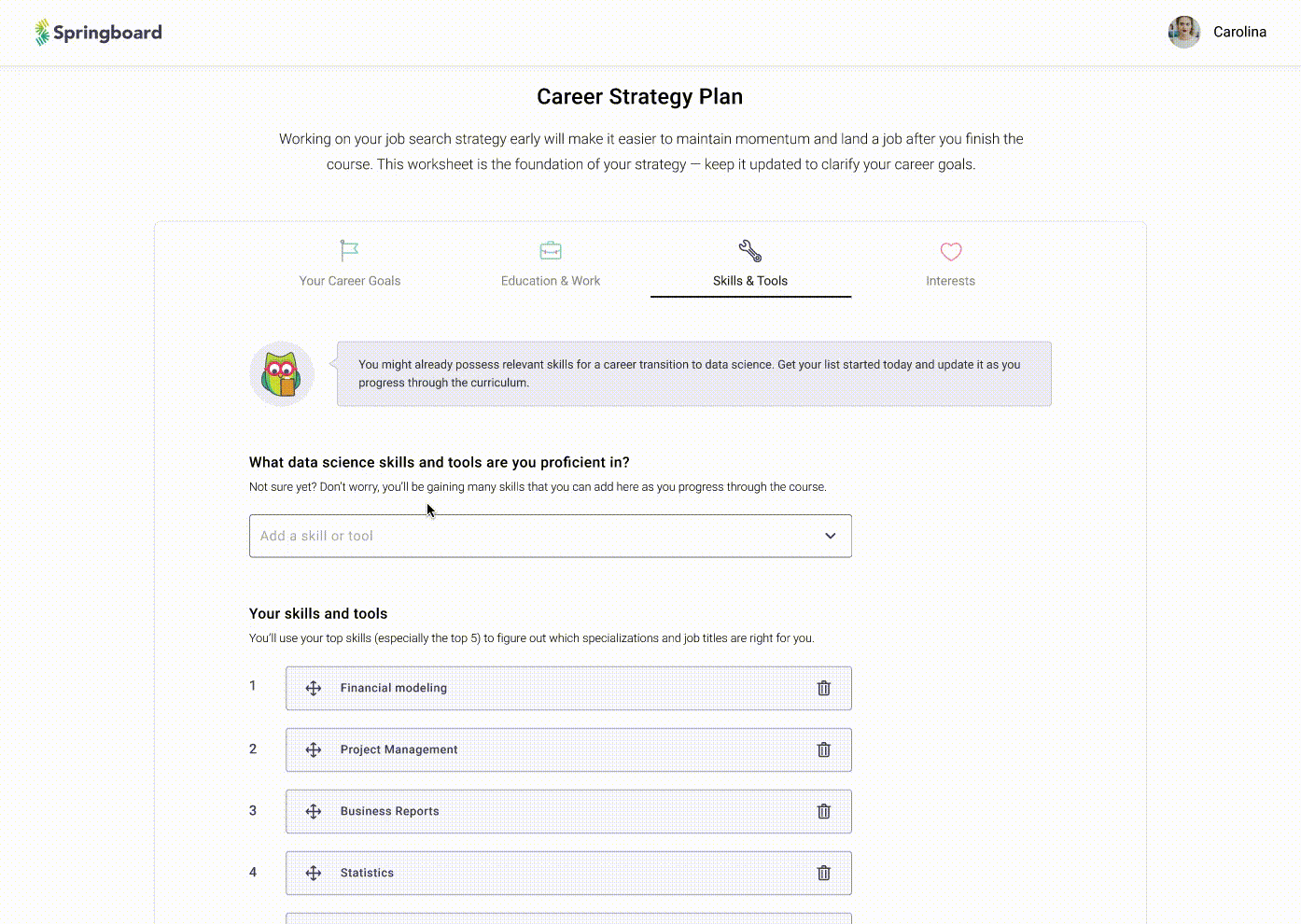SPRINGBOARD CAREER STRATEGY PLAN
Role: Research, UX, UI
DURATION: MAR 2020 - APR 2020
PLATFORM: DESKTOP & MOBILE WEB
Problem
At Springboard, we believed that students should start preparing for their job search at the same time that they begin the course so that they hit the job market ready with strategy. This approach has proven successful and resulted in low refund rates compared to competitor bootcamps with similar money-back-guarantee models.
At the end 2019, Career Services introduced a Career Strategy Plan at the top of the career curriculum to solve two problems:
Students start thinking about their career strategy, job titles, industries, relevant experience
Career coaches can quickly understand a student's background and over time help them find the best fit jobs
However, the document was off-platform, uninspired, and asked open-ended questions that would be too difficult for someone new to the field to come up with their own answers, resulting in low fill rate and poor effort. Moreover, both students and coaches never revisited the worksheet as the former progressed through the course.
At the same time, our Job Placement team was building a tool to match graduates with opportunities that we were sourcing from partners and broader job market. They had ample data from job descriptions, but lacked critical information from our students (relevant experience, strengths, top skills, preferred locations, etc).
Objective
Productize the Career Strategy Plan to simultaneously improve fill rate and engagement, while also collecting information about student’s experience, skills, and interests — thereby enabling job fit and job recommendations in the future.
Research Findings
To concretely understand the Career Strategy Plan’s value and user behavior, I surveyed ten career coaches, interviewed six students, and worked with our analyst to evaluate current engagement patterns.
Consistent with what Career Services reported, only 14% of students submitted their plan prior to their first coaching call. However, we also discovered that an additional 40% completed theirs days later. It turns out that the placement of the career strategy plan in the curriculum did not clearly suggest that it was a pre-requisite to the first coaching call.
On the Career Strategy Plan’s value over time, coaches and students unanimously reported that the latter’s answers have changed during their 6-9 month learning journey, suggesting that it needs to be revisited multiple instances before course completion. Both parties also stressed the importance of setting accurate and realistic job expectations early and actively adjusting strategies.
“On the call, I walk through each section (past experience, preferences, etc) with the student and discuss how they are important to their job search and networking strategy moving forward.”
“I really underestimated the extent of the job search process. ”
A Plan That Changed with the Student
Given what I learned about the evolution of a student’s career strategy throughout their learning journey, the redesign of the Career Strategy Plan must support multiple instances of recurrence and revision.
Bringing the Career Strategy Plan onto the Platform
The first decision I made was to convert the Career Strategy Plan from its original format as a Google doc into a digital form that lived on platform. This way, we were able to save the data each time revisions are made and introduce it into multiple points during the students learning journey.
Fields That Scale
Our adult learners constituted a diverse range of experiences, ranging from high school grads to career pivoters with decades of experience. Given this spread, they could have very little or a laundry list to enter into the Education & Work section. As such, I designed a form that both required minimal effort for the former and accommodated the rich work history of the latter.
Fields That Evolve with the User
While some fields will not change much or at all over a student’s learning journey (e.g., those related to past experience), others are highly variable (e.g., top skills and tools), necessitating a UI interaction pattern that lets the student easily update their answers over time.
Timely and Accessible
I worked with the Head of Career Services to identify two additional milestones in the learning journey where a student and their coach should revisit the former’s career strategy—1) when they choose job titles they want to pursue and 2) right before course completion. Because the Career Strategy Plan now lives on platform, we were able to insert it anywhere in the curriculum.
We also gave it a permanent home among other features that a student regularly references throughout their learning journey.
Collecting the Right Data for the Job Fit Tool
At the same time that I was redesigning the Career Strategy Plan, we were also scaling our job placement services — feeding job opportunities to graduates who were a match. A member of the team was manually assembling student profiles using information from different sources (LinkedIn, their student profile, call notes). To scale this effort, our analysts developed a job fit model that would help us shortlist students for specific opportunities.
The original career strategy plan already asked for some of these answers, albeit in an unstructured manner that wasn’t directly applicable. My job was to re-factor the career strategy plan to ask questions and collected data that cleanly ported into the job fit.
An Improved Job Search Experience
The productization of the Career Strategy Plan succeeded in improving student job search preparedness and jump started them with opportunities post-graduation.
Students are able to update their career goals and strategy across their learning journey with ease
Coaches can to work with students to set accurate job expectations early and actively adjust strategies over time
The same data that students inputted and updated over time are fed into a job fit tool, which in turn supplied them with right-fit job job recommendations to apply for.

